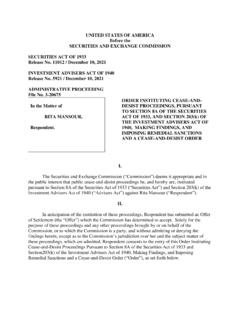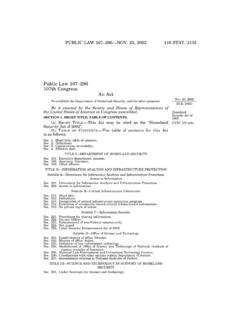Transcription of The Cabinet Manual - GOV.UK
1 The Cabinet Manual A guide to laws, conventions and rules on the operation of government 1st edition October 2011 The Cabinet Manual A guide to laws, conventions and rules on the operation of government 1st edition October 2011 Foreword by the Prime Minister On entering government I set out, with the Deputy Prime Minister, our shared desire for a political system that is looked at with admiration around the world and is more transparent and accountable. The Cabinet Manual sets out the internal rules and procedures under which the Government operates. For the first time the conventions determining how the Government operates are transparently set out in one place. Codifying and publishing these sheds welcome light on how the Government interacts with the other parts of our democratic system. We are currently in the first coalition Government for over 60 years.
2 The Manual sets out the laws, conventions and rules that do not change from one administration to the next but also how the current coalition Government operates and recent changes to legislation such as the establishment of fixed-term Parliaments. The content of the Cabinet Manual is not party political it is a record of fact, and I welcome the role that the previous government, select committees and constitutional experts have played in developing it in draft to final publication. Cabinet has endorsed the Cabinet Manual as an authoritative guide for ministers and officials, and I expect everyone working in government to be mindful of the guidance it contains. This country has a rich constitution developed through history and practice, and the Cabinet Manual is invaluable in recording this and in ensuring that the workings of government are far more open and accountable.
3 David Cameron Prime Minister iii Preface by the Cabinet Secretary Before the last general election, the previous Prime Minister, the Rt Hon Gordon Brown MP, asked that I lead work to produce a Cabinet Manual to provide a source of information on the laws, conventions and rules that affect the operation and procedures of the Government. With the endorsement of the current Prime Minister and Deputy Prime Minister, I published a draft in December 2010. The draft generated considerable interest, including from three Parliamentary Select Committees, as well as from a number of constitutional experts, interest groups and members of the public. Their reports and comments have been extremely valuable in identifying areas of controversy, errors or omissions, and areas where the draft could be improved. On the whole, the process also demonstrated general support for the principle of the Cabinet Manual and the contents of the draft.
4 A summary of the comments received has been published separately. Over the past eight months, the Cabinet Secretariat has worked with colleagues from across government to review all the comments we received and to revise and update the text. In addition to a significant number of detailed changes, the revised text incorporates important changes to aid understanding of the contents in particular extensive references and links to more detailed guidance, and a glossary. This updated text the first edition of the Cabinet Manual remains true to its original purpose. It is primarily a guide for those working in government, recording the current position rather than driving change. It is not intended to be legally binding or to set issues in stone. The Cabinet Manual records rules and practices, but is not intended to be the source of any rule. While the document primarily provides a guide to the operation of the Government itself, it also sets out from the view of the Executive the Government s place in the UK s Parliamentary democracy.
5 It therefore includes chapters on how the Government relates to the Sovereign, Parliament and the independent judiciary, as well as the other democratic institutions within the UK and key international bodies. The content of the Cabinet Manual is not static, and the passage of new legislation, the evolution of conventions or changes to the internal procedures of government will mean that the practices and processes it describes will evolve over time. If the Cabinet Manual is to continue to play a useful role as a guide to the operations and procedures of government, it will need to be updated periodically to reflect such developments. iv Preface by the Cabinet Secretary While some other administrations, most notably New Zealand, have developed their equivalent documents over a number of decades, this first edition of the Cabinet Manual has been produced in less than two years.
6 This has been an intensive process and I am grateful to all those who have contributed to this achievement. I am confident that the Cabinet Manual will come to be seen as an essential guide to our system of government and I hope that everyone working in, or with, the Government will use it as a key work of reference. Sir Gus O Donnell Cabinet Secretary v vContents Introduction 2 Parliamentary democracy 2 The UK constitution 2 The Sovereign 3 Parliament 3 The Prime Minister and ministers 3 The judiciary 4 European Union and other international law 4 Chapter One The Sovereign 6 Ceremonial and constitutional duties 7 The Royal Prerogative 8 Succession and coronation 8 Absence and incapacity of the Sovereign 8 The Privy Council 8 The Established Church 10 Chapter Two Elections and government formation 12 General elections 13 Meeting of the new Parliament 13 The principles of government formation 14 Parliaments with an overall majority in the House of Commons 14 Contents Parliaments with no overall majority in the House of Commons 14 Change of Prime Minister or government during a Parliament 15 Pre-election contact with opposition parties 16
7 Dissolution of Parliament 16 Finalisation of Parliamentary business 16 Restrictions on government activity 17 Chapter Three The Executive the Prime Minister, ministers 20 and the structure of government The Prime Minister 21 Ministers 22 Powers of ministers 23 Ministerial conduct 26 The structure of government 26 Chapter Four Collective Cabinet decision-making 30 Principles of collective Cabinet government 31 Cabinet 31 Political Cabinet 32 Cabinet committees 32 Business of Cabinet and Cabinet committees 33 Procedures of Cabinet and Cabinet committees 34 The Cabinet Secretariat 36 The Cabinet Secretary 36 Chapter Five The Executive and Parliament 38 The House of Commons and the House of Lords 39 Core principles 40 Government business 40 Scrutiny of the Government 41 Legislation 41 Public appointments 44 The Parliamentary Commissioner for Administration 44 The Comptroller and Auditor General and the National Audit Office 45 The Cabinet Manual Chapter Six The Executive and the law
8 48 The Law Officers 49 litigation involving ministers 50 Legal advice and legal professional privilege 51 Indemnity of legal costs 52 The European Convention on Human Rights and the Human Rights Act 1998 52 The Treasury Solicitor and the Government Legal Service 53 Public inquiries 53 Relations with the judiciary 53 Chapter Seven Ministers and the Civil Service 56 The Civil Service 57 The role of ministers and officials 57 The Civil Service Code 57 The role of permanent secretaries 58 The role of special advisers 58 Civil servants evidence to Parliamentary select committees 59 Public appointments 59 Chapter Eight Relations with the Devolved Administrations 62 and local government Devolution 63 Parliament and legislation 64 Scotland 64 Wales 64 Northern Ireland 65 Relations with the Devolved Administrations 65 funding of devolution 66 Local government in England 67 Chapter Nine Relations with the European Union and other 70 international institutions European and other international organisations 71 The role of ministers 71 Contents Collective agreement of international policy 71 Meetings 72 Implementation of international decisions and law 73 Parliamentary scrutiny 76 Chapter Ten Government finance and expenditure 80 The role of Parliament 81 Budget and Spending Reviews 81 The Supply Estimates process 82 Treasury approval of expenditure 83 Departmental governance arrangements 83 The role of the accounting officer 83 Government accounts 84 Chapter Eleven Official information 88 Ministerial records 89 Maintaining the official record 90 Publishing data 90 Access to information 90 Access to papers of a previous administration 92 Disclosure and use of
9 Official information by the Prime Minister and ministers 92 Prime Ministers records on leaving office 92 Memoirs and the Radcliffe Rules 93 Annex Election timetable 96 List of abbreviations 98 Glossary 99 Reference documents 106 Introduction Parliamentary democracy 1. The UK is a Parliamentary democracy which has a constitutional sovereign as Head of State; a sovereign Parliament, which is supreme to all other government institutions, consisting of the Sovereign, the House of Commons and the House of Lords; an Executive drawn from and accountable to Parliament; and an independent judiciary. 2. Constitutional convention is that executive power is exercised by the Sovereign s Government, which has a democratic mandate to govern. Members of the Government are normally Members of the House of Commons or the House of Lords and the Government is directly accountable to Parliament.
10 The government of the day holds office by virtue of its ability to command the confidence of the House of Commons. Elections are held at least every five years to ensure broad and continued accountability to the people. Election candidates can stand independently but they usually represent political parties, and party numbers in the House of Commons determine the composition of the Government. 3. Parliament is sovereign and it has provided by Acts of Parliament which, by their nature, may be repealed for certain issues to be considered and determined at different levels: within the European Union (EU); by the Devolved Administrations; and by local government. The UK constitution 4. The UK does not have a codified constitution. There is no single document that describes, establishes or regulates the structures of the state and the way in which these relate to the people.















